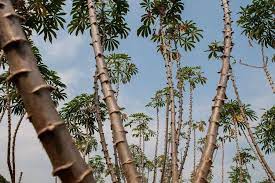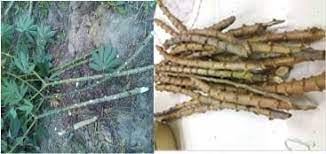Cassava branches, also known as cassava stems or cassava stalks, are a key component of the cassava plant (Manihot esculenta). Cassava is a tropical root crop that is widely cultivated for its starchy tuberous roots, which are a significant source of carbohydrates in many parts of the world. The branches of the cassava plant play an essential role in its growth and propagation.
Cassava branches are woody and typically green or brown in color. They are cylindrical in shape and can vary in thickness, depending on the age of the plant. Younger branches tend to be thinner and more flexible, while older branches become thicker and more rigid. Cassava is a perennial plant, and its branches grow from the main stem or trunk. These branches extend outward from the central stem and bear the leaves, flowers, and eventually the tuberous roots.
Cassava branches support the plant’s characteristic palmate leaves. The leaves are typically green, with five to seven lobes radiating from a central point. They provide the plant with the ability to photosynthesize and produce energy. Cassava plants produce small, inconspicuous flowers on their branches. These flowers are typically white or pale green and are either male or female. Cross-pollination between male and female flowers is necessary for seed production, although cassava is primarily propagated through stem cuttings rather than seeds.
One of the most crucial functions of cassava branches is their role in propagation. Farmers and gardeners often use stem cuttings from mature cassava plants to grow new ones. These cuttings typically consist of sections of cassava branches that are several inches long. When planted in the ground, these cuttings can develop into new cassava plants, which will eventually produce tuberous roots for harvesting.
Cassava branches grow relatively quickly, with new leaves and stems emerging regularly, particularly during the plant’s growing season in tropical regions. While cassava branches are primarily used for propagation, they are also sometimes used for animal fodder or as a source of energy in biomass production. In some cultures, young cassava leaves are also used as a leafy vegetable in cooking.
It is important to note that cassava branches are just one part of the cassava plant, which is valued for its tuberous roots as a major source of carbohydrates in many tropical and subtropical regions. Proper management of cassava branches, such as selecting healthy cuttings for planting, is crucial for successful cassava cultivation.
The Economic Importance and Uses of Cassava Branches

Cassava branches, like many parts of the cassava plant, have several economic uses and importance, particularly in regions where cassava is a staple crop.
Here are some of the economic uses and importance of cassava branches:
1. Propagation: Cassava branches are commonly used to propagate new cassava plants. Farmers can cut healthy cassava branches into segments, each containing one or more nodes, and plant them in the ground. This is an essential method for expanding cassava cultivation, as it allows farmers to multiply their cassava plants without the need for seeds.
2. Genetic Diversity: Cassava branches are used to maintain genetic diversity within cassava varieties. By selecting branches from healthy, high-yielding plants, farmers can preserve and propagate desirable traits in the cassava crop.
3. Livestock Feed: Cassava branches can be used as livestock feed. While cassava roots are the primary part of the plant consumed by humans, branches can be fed to livestock like cattle, goats, and pigs. However, it’s essential to process the branches correctly to reduce their cyanogenic content, which can be harmful to animals.
4. Organic Matter: When cassava branches are pruned or removed from the plant, they can be used as organic matter to improve soil fertility. Farmers can incorporate cassava branches into their compost piles or directly into the soil to increase its organic content and nutrient levels.
5. Cassava Leaf Production: Although not the branches themselves, cassava leaves, which are attached to the branches, have economic value. Cassava leaves are edible and can be harvested and sold as a source of income or used for household consumption.
Read Also: Cassava Inflorescence: Economic Importance, Uses and By-Products
6. Energy Production: In some regions, cassava branches are used as a source of biomass energy. They can be burned as fuel to produce heat or electricity, providing an alternative energy source for cooking, heating, or generating power in areas with limited access to conventional fuels.
7. Crafts and Construction: In certain cultures, cassava branches are used for crafting purposes and in traditional construction techniques. They can be woven into baskets, mats, fences, and other items.
8. Erosion Control: Cassava branches can be used for erosion control. Planting cassava on slopes or in areas prone to erosion helps stabilize the soil and prevent the loss of topsoil.
9. Income Generation: The sale of cassava branches, especially when they are used for propagation, can provide additional income for cassava farmers.
10. Biological Pest Control: Cassava branches can serve as a habitat for beneficial insects and predators that help control pest populations in cassava fields, contributing to reduced pesticide use and improved crop health.
11. Carbon Sequestration: Cassava plants, including their branches, absorb carbon dioxide from the atmosphere during photosynthesis. By planting and maintaining cassava, farmers indirectly contribute to carbon sequestration, which has environmental benefits.
The Products and By-products That Can Be Derived From Cassava Branches
Cassava (Manihot esculenta) is a versatile plant with numerous parts that can be used to create various products and by-products. Cassava branches, which are often discarded or left unused, can also be utilized in several ways.
Here is a list of products and by-products that can be derived from cassava branches:
1. Fuelwood: Cassava branches can be used as a source of fuelwood. They are burned to produce heat and energy for cooking and heating purposes.
2. Charcoal: Cassava branches can be converted into charcoal through a process of carbonization. Charcoal is a valuable source of fuel for cooking and industrial purposes.
3. Biomass Energy: Cassava branches can be used to generate biomass energy, either by burning directly or by converting them into biogas through anaerobic digestion. This energy can be used for electricity generation or as a cooking fuel.
4. Animal Feed: Cassava branches can be processed and used as animal feed. They are rich in carbohydrates and fiber, making them suitable for livestock, particularly ruminants like cattle.
5. Mulch: Cassava branches can be chipped or shredded and used as mulch in agricultural fields. Mulch helps retain soil moisture, control weeds, and improve soil health.
6. Compost: Cassava branches can be composted to create organic fertilizer. When broken down, they add nutrients to the soil and improve its structure.
7. Handicrafts: Cassava branches can be used in the production of handicrafts. They can be carved, shaped, and used for making decorative items like baskets, mats, and wooden art pieces.
8. Erosion Control: Cassava branches can be employed in erosion control and slope stabilization projects. They are often used to create barriers that prevent soil erosion.
9. Mushroom Cultivation: Cassava branches can serve as a substrate for growing mushrooms. The lignocellulosic nature of the branches provides an excellent medium for mushroom cultivation.
10. Biochar: Cassava branches can be converted into biochar, a form of charcoal used to improve soil fertility, sequester carbon, and enhance soil structure.
11. Paper and Pulp: Cassava branches can be used in the production of paper and pulp. The cellulose fibers in the branches can be extracted and processed to make paper products.
12. Wooden Products: Although cassava branches are not a primary source of timber, they can still be used to make small wooden products like utensils, toys, and furniture components.
13. Medicinal Uses: Some traditional medicine systems use parts of cassava, including the branches, for various remedies. However, the safety and efficacy of such uses may vary and should be approached with caution.
In conclusion, it is important to note that the utilization of cassava branches may require proper processing, treatment, or preparation to make them suitable for their intended purposes. Additionally, sustainable harvesting and management practices should be followed to ensure the long-term availability of cassava branches as a resource.
Read Also: How To Educate Yourself On Climate Change

